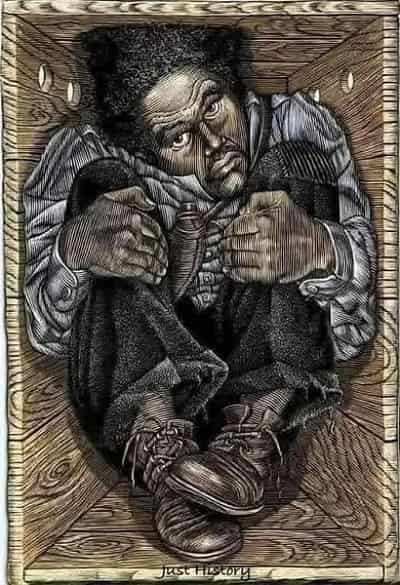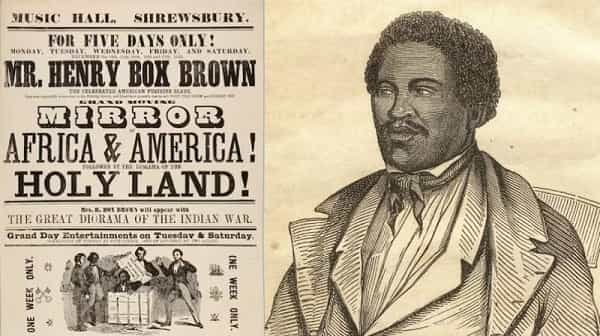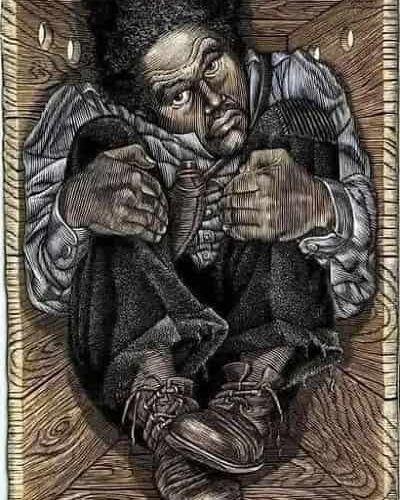Henry “Box” Brown: The man who shipped himself to freedom

Henry Box Brown’s life is a powerful story of courage, creativity, and resistance. Born into slavery, he escaped in a wooden box, became a famous speaker, and later used magic to fight racism.
His journey inspires people even today. Let’s explore how he turned tragedy into triumph.
Early Life in Slavery
Henry Box Brown was born around 1816 in Virginia, USA. His ancestors were African people kidnapped and forced into slavery in America. As a child, Henry worked on a plantation. Later, he was sent to Richmond, Virginia, to work in a tobacco factory. Though enslaved, Henry married and had children. But his life changed forever in 1848 when his family was sold to another slave owner.
One day, Henry watched helplessly as his wife and children were marched away with 350 other enslaved people. This heartbreaking moment made him vow to escape slavery, no matter the cost.
The Daring Escape: Mailed to Freedom
After losing his family, Henry prayed for a way to freedom. Suddenly, an idea struck him: he would mail himself to a free state in a box! With help from two friends, Henry squeezed into a wooden crate labeled “dry goods.” The box was nailed shut and sent by train, boat, and wagon to Philadelphia—a journey of 27 hours.
Inside the box, Henry faced terrible conditions. At times, he was upside down, struggling to breathe. But when abolitionists opened the box, he rose alive, singing a hymn of freedom. His escape made headlines, and he became known as “Henry Box Brown.”
Life as a Free Man: Abolitionist Speaker
After escaping, Henry joined the abolitionist movement. He traveled across the U.S. and England, sharing his story. Famous speakers like Frederick Douglass also spoke out against slavery, but it was dangerous work. Laws like the Fugitive Slave Act allowed enslavers to capture freed people like Henry.
By 1850, Henry moved to England for safety. There, he continued speaking but faced criticism from white abolitionists who disliked his bold style. Henry didn’t just tell his story—he used music, art, and drama. This creative approach eventually led him to a new career: magic.
Becoming the Subversive Magician
In England, Henry Box Brown reinvented himself as a performer. He called himself the “Great African Magician” and wore colorful costumes. His shows mixed magic tricks with messages about slavery’s horrors. For example, he used boxes in his acts to symbolize both his escape and the suffering of the Middle Passage (the voyage of enslaved Africans across the Atlantic).

Henry also used humor to challenge racism. In one trick, he hypnotized audience members to act like farm animals—a funny but sharp critique of stereotypes that labeled Black people as “less than human.” His performances were entertaining, but they always carried a deeper meaning.
Fighting Racism Through Magic
Henry’s magic shows were more than just entertainment. They were acts of rebellion. In 1852, he sued a newspaper writer who claimed slavery wasn’t cruel. Henry won the case, proving his courage to stand up for truth.
Scholar Martha Cutter explains that Henry’s performances “flipped the script” on racism. For example, when he made white audience members behave like animals, he turned racist ideas upside down. His magic was a tool to reclaim power and dignity.
Later Years in Canada
After slavery ended in the U.S. in 1865, Henry returned with his second wife and children. They settled in Canada, first in London, Ontario, and later in Toronto. Henry continued performing, even singing onstage with his family.
Henry Box Brown died in Toronto in 1897. For years, his grave was forgotten, but recently, historians and local activists have worked to honor his legacy. In 2022, a laneway in Toronto’s Corktown neighborhood was named “Henry Box Brown Lane” near his former home.
Honoring Henry Box Brown Today
Henry’s story is now celebrated as part of Black history. Artists, writers, and scholars study his life as an example of creativity and resistance. In Toronto, community members like Coralina Lemos and Pancheta Barnett pushed to recognize his contributions.
“This is historical revelation,” Barnett says. “We can’t forget people like Henry Box Brown.”
FAQs About Henry Box Brown
How did Henry Box Brown escape slavery?
He mailed himself in a wooden box from Virginia to Philadelphia, a 27-hour journey.
Why is he called “Box” Brown?
He added “Box” to his name after his famous escape.
What did Henry do after escaping slavery?
He became a speaker and magician, using performances to criticize slavery and racism.
Why did Henry Box Brown move to England?
U.S. laws made it unsafe for him; England abolished slavery earlier.
How did Henry use magic to fight racism?
His tricks mocked racist stereotypes, like hypnotizing people to act like animals.
Where is Henry Box Brown buried?
He died in Toronto, Canada, in 1897.

